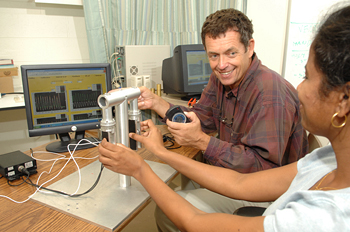
According to the Multiple Sclerosis Society, Jaric's second society-funded study could lead not only to improved assessment but also to treatment of people experiencing problems with hand function. Jaric is a member of a team of more than 300 investigators in the world whose research is supported by the MS Society.
Hand function encompasses two forces: a precise hand force against an external object (as when a hand pushes against a table or manipulates a tool) and a sufficient hand-grip force when a hand grasps an object such as a cup.
Some persons with MS and other neurological diseases do not coordinate these forces well, and some may have mild symptoms that may seem almost “normal. “To determine hand function, doctors generally asks patients to squeeze their hands and to perform simple tasks that mimic everyday actions while observing them,” Jaric said, noting that this is a crude and not very reliable method of measuring performance.
Jaric has developed tools, which when linked to a computer, measure hand function more accurately and consistently. When a person performs tasks like grasping, relaxing or exerting force by pressing and pushing, a graph appears on the screen showing how efficient the hand function is. In addition to a comprehensive device that records all the components of forces and torques that two hands can independently exert, the most recently developed experimental device is small, light and easy to use. Jaric said he hopes that the tool can gradually be developed into a standard diagnostic tool.
“The sophisticated tools we are developing give measurements that are far more accurate and sensitive than observation. The results can detect the progress of the disease and also measure the effectiveness of pharmaceutical and therapeutic procedures in treating patients,” Jaric said.
“My research on hand function involves patients with different neurological problems. In addition to studying persons with MS, we have performed pilot testing of individuals with cerebral palsy,” Jaric said.
Jaric also has studied the hand function of healthy individuals, which has led to increased understanding and knowledge of how the hand performs. The grant proposals recently submitted to federal agencies are based on the investigation of specific aspects of hand function in both healthy individuals and neurological patients.
Jaric received his bachelor's, master's and doctoral degrees from the University of Belgrade and joined the UD faculty in 2002 from the University of Umea in Sweden. His research interests are motor control and learning and sports biomechanics.
Article by Sue Moncure
Photo by Kathy F. Atkinson

